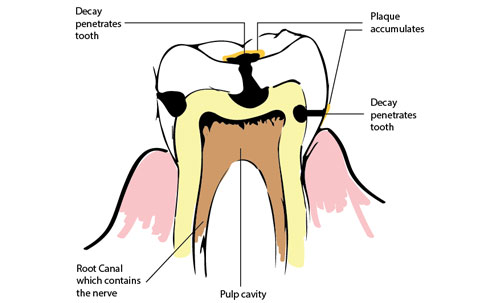Dental decay is the result of bacterial activity in the mouth that produces acids and damages the external layers of tooth, namely enamel and underlying dentin. There are many types of bacteria normally residing in our mouth, which combine with food debris accumulated on the surfaces of teeth and form plaque.
 This plaque also contains harmful bacteria, which produce acids on the layer of teeth, and cause dental decay (called dental caries in the clinical terms. This acid dissolves the outermost enamel layer, and can also penetrate to next layer called dentin.
This plaque also contains harmful bacteria, which produce acids on the layer of teeth, and cause dental decay (called dental caries in the clinical terms. This acid dissolves the outermost enamel layer, and can also penetrate to next layer called dentin.
When dentin also gets affected, the enamel over it breaks down and the result is a cavity. This cavity needs intervention by a dentist, or else it further goes deeper into the pulp region, the innermost region in a tooth. This gives rise to painful inflammation and infections, which may even penetrate bone, if not treated in time.
Symptoms:In early stages of dental decay, it may not show any symptoms.
But once it erodes the enamel and reaches the underlying dentin, one may experience tooth sensitivity, which is a sharp and sudden pain caused by cold, hot, sweet and sour substances.
Once the decay leads to a cavity, the surface of the tooth gets eroded, turns blackish in colour, and roughness can be felt by tongue. If the infection has gone deep into the innermost layers of tooth, severe pain may result.
Treatment:It is true that prevention is way better than cure. The chances of good treatment depend on how early the problem is detected. If detected in earliest of stages, caries may be reversed, and remineralization may be done. But if the decay has already taken place, it requires immediate professional care by a dentist.
The dentist may use various methods to detect the problem, like using some instruments like mouth mirror and explorer, to even X-rays to determine the extent. If the decay or cavity is limited to enamel and dentin, restoration with various filling material may be done.
If the cavity is very large, there might not be enough enamel left to support the tooth and the filling. In this case, the dentist will cover the filled tooth with a cap, called artificial crown.
If the cavity has gone deeper and reached the pulp area, it is certain that the infection has reached the innermost layer of a tooth. In this case, the dentist will need to undertake an RCT, the root canal treatment.